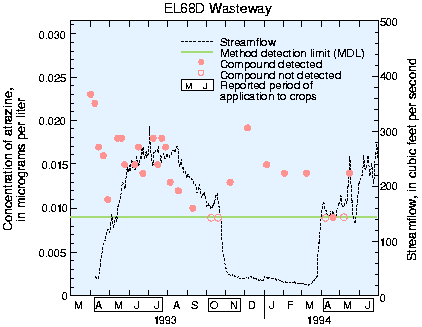Like nitrate, soluble pesticides such as atrazine, metribuzin, and simazine can leach to ground water in the Quincy-Pasco subunit and later be transported to agricultural wasteways [2, 20]. Atrazine present in EL68D Wasteway during base flow comes from ground-water discharges to the wasteway (fig. 26).
Ground-water discharges make up a large percentage of the total load of some compounds transported by a wasteway. About 40 percent of the atrazine discharged annually by EL68D Wasteway enters via the ground water. For Crab Creek Lateral, the percentages for atrazine and other compounds are somewhat lower (table 3).
In summer, the wasteways also carry unused irrigation water and runoff of excess irrigation water that contains additional pesticides from the fields.

Figure 26. Concentrations of atrazine, a soluble pesticide, do not decrease during base flow.
Table 3. Estimated contributions of ground-water discharges to annual load [N, Nitrogen; %, percent]
Ground-water quality is highly variable, requiring many samples to detect trends; therefore, it may be advantageous to sample surface drains during winter to monitor trends in ground-water quality. Sampling discharges from subsurface field drains, which collect and drain ground water to prevent waterlogging of fields, may also be useful. Figure 27 shows median concentrations of pesticides, nitrate, and chloride were similar (and usually not statistically different) among samples from monitoring wells, subsurface drains, and wasteways sampled during winter base flow. Concentrations in samples from wells usually varied the most because these samples represent only a small part of the aquifer. Because waters in wasteways and subsurface drains represent the largest ground-water volumes, concentrations in these samples usually varied the least; therefore, fewer samples are necessary for trend analysis.
For examples using nitrate concentrations in wasteways to infer trends in nitrate in ground water, see page 9.
Figure 27. Median concentrations of pesticides, nitrate, and chloride are similar in ground water, subsurface drains, and surface water sampled during base flow.